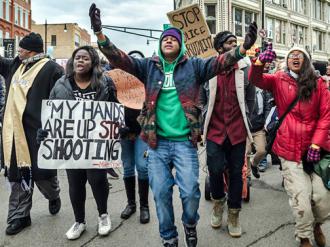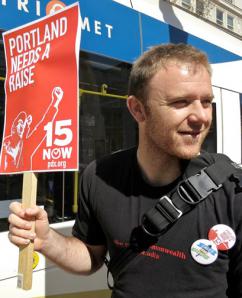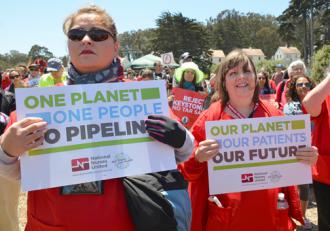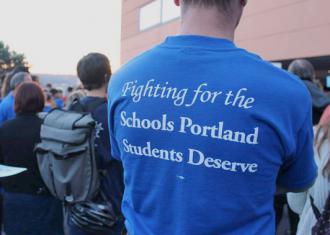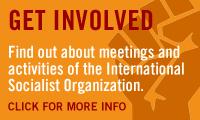Chris Beck and Madelynn Kay report on how parents, teachers and students in Portland, Ore., stood up–and made school officials back down on school closures.
Portland stops the closures! We CAN stand up and fight back!
http://activeresource.org/wordpress/archives/255
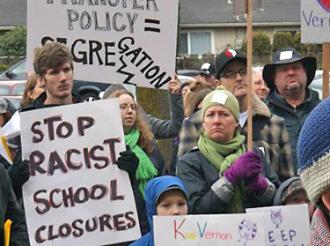 Portland residents protest proposed school closures
Portland residents protest proposed school closures
WEEKS OF community protest paid off on February 12, when the Portland Public Schools (PPS) superintendent announced her recommendation to the school board--no school closures.
Over the last month, district officials have floated several proposals for "enrollment balancing," all of which included closing schools that serve high-minority, low-income populations. But the latest proposal, after weeks of community protest, spares all neighborhood schools from closure.
All of the proposed closures were in the Jefferson cluster, a grouping of schools that has historically fed into Oregon's only majority Black high school. As teacher Elizabeth Thiel wrote in the Oregonian:
People in the Jefferson cluster have been through this before. We were among those experimented on with the great K-8 transition seven years ago. We had all our neighborhood middle schools taken away. We've seen a boys academy and a girls academy come and go.
Jefferson High School has been redesigned more times, I think, than anyone can keep track of. Last spring, two of our schools were closed without warning or discussion. I think I speak for a lot of people when I say that we are tired of it.
The Jefferson cluster is located in North Portland, a neighborhood that is home to the highest concentration of African Americans in Oregon. But over the last decade, middle-class white families, encouraged by the city's urban renewal plan, have increasingly gentrified the community.
As the neighborhood demographics changed, current Gates Foundation education director and then-PPS Superintendent Vicki Phillips pushed through market-based restructuring strategies using "school choice." These policies allow more affluent, mostly white students to transfer away from the so-called "failing" schools in the Jefferson cluster.
So while across the country, most schools are segregated because neighborhoods are segregated, in Portland, schools are segregated by design. As Thiel points out:
In a neighborhood where 72 percent of the population is white, 90 percent of my students this year are of color. Despite the increasing affluence of my neighborhood, most of my students are living in poverty. Where are all the white kids? Apparently, they have transferred elsewhere, like so many others who live in the cluster."
- - - - - - - - - - - - - - - -
THESE AREN'T the first closures in the Jefferson cluster. Last year, Harriet Tubman Leadership Academy for Young Women and Humboldt PK-8 were closed without any community input or discussion.
In fact, over the last 10 years, PPS has closed more schools in the Jefferson cluster than all other school clusters combined. The district cites low enrollment in the neighborhood schools as the reason for closing them but until recently has ignored the transfer policy that is causing this disaster.
On January 14, the district released two options to shut down more neighborhood schools. In response to the proposals, several hundred parents, teachers and students rallied at Jefferson High School outside of a district-organized community forum.
At the rally organized by Social Equality Educators (SEE), former Jefferson teacher Adam Sanchez and Portland Association of Teachers President Gwen Sullivan apologized for not uniting with parents earlier to stop school closures. "I think the teachers who are here today realize that we made a mistake in not fighting this fight with parents and community members earlier," Sanchez said.
In her speech, Sullivan reaffirmed this perspective:
My first year as president, I made a big mistake and I'm not going to let that happen again. We should have been outraged that they gave us one hour before announcing to the public that they were going to close Humboldt and Tubman. And we didn't yell and scream about it. That is not the way to engage a community, a neighborhood, parents, kids. That's not how you treat people.
After Sullivan spoke, SEE opened the microphone to a flood of parents and students who came to speak out against these racist school closures.
Some of the first to come up to the microphone were Jefferson High School students. Senior Uriah Boyd read a poem about the pride she had as a Jefferson student and her encounters with racist stereotypes about her school.
She exclaimed, "Urban stereotypes ain't got shit on our legacy--these rooms are oozing with excellence. And until you sat in a class and observed our discussions, your opinion is completely irrelevant."
Parent Virginia Walker spoke out demanding an end to the districts transfer policy, "They try to say that they cannot make individuals stay in their community neighborhood schools and that is a complete and utter lie. Because when I was younger, you were not allowed to transfer out of your boundaries, you had to stay in your neighborhood school."
It was particularly heart-wrenching to see several elementary school students from the schools on the chopping block plead to keep their schools open. As one young student told the crowd, "I just want to say, what ever school you're from, you should always think about other people and their schools."
After everyone was given the opportunity to speak out about the cuts, organizers led a march into the district's meeting. The throngs of protesters, plus several hundred additional attendees, were greeted with hot beverages, cookies and assorted goodies. Aimed at presenting a warm, hospitable face to the public, the district's snacks, free child care and warm-sounding rhetoric did little to disarm the unhappy crowd.
This was the first "rebalancing" meeting open to the entire Jefferson cluster community. Superintendent Carole Smith claimed that she wanted folks' "best thinking" on how the Portland School District could better serve their elementary and middle school students. Yet parents and families present could only weigh in on one of two pre-selected options--both of them containing proposed school closings.
A grandmother of a local student spoke first. "These meetings are meant to make us feel like we have input into the decision...How do we know our voices are actually being heard by PPS?" she said.
Parents, teachers and students took the floor one at a time to confront the PPS officials at the front. One parent exclaimed, "We want commitment! We want resources! We want to be treated like every other single cluster in this Portland District!"
A teacher in the cluster spoke next: "This has been called a problem of enrollment, of growth, of capture rates, or even of test scores. This is really a problem of segregation." The cafeteria erupted in applause as the crowd leapt to their feet.
"[The] transfer policy is racist, it's classist, and it's wrong!" said another parent, who was cheered by more applause. People felt confident declaring the inherent racism they had experienced and witnessed as people living and working in North Portland.
As the meeting continued, people boldly spoke out against the PPS transfer policy, and pressured the school board to stop enabling parents to simply opt their child out of his or her neighborhood school.
Students, teachers and families repeatedly identified the transfer policy as the root of the problem, claiming the policy and the district's proposed solutions target an already marginalized community of Blacks, Latinos and students with disabilities. They demanded that all students have access to an equal education and that the district invest in public neighborhood schools.
"Jefferson cluster history is a trend of disinvestment from the Jeff community schools," one parent said. "The discussion about enrollment balancing is a distraction--we need to have a discussion about equity. We can't close the achievement gap when we're closing our schools. Please address the problem of segregation in our schools."
- - - - - - - - - - - - - - - -
IN PAST meetings, the district successfully pitted school against school, but here parents and teachers stood together in solidarity. Many in the room were energized by the emerging alliances forged in real time through this struggle. Portland community members explained how the district sought to divide groups based on class and race and saw working together as the key to defeating these closures.
After this beautiful display of resistance, Superintendent Carole Smith withdrew her support for either option, both of which would have closed schools at the end of this year. But her revised plan put a new school on the chopping block, merging Chief Joseph Elementary School with Ockley Green K-8 the following year.
On February 11, the School Board held a meeting to discuss this new proposal, where again parents lambasted the district leadership. The meeting began with parent, student and teacher input. One of the first speakers, parent and community member Terrance Moses, told the board, "PPS has been good at one thing: proving itself untrustworthy to the Jefferson Cluster."
He went on to tell the board and superintendent, "We've had disruption for the last decade...don't force us to go through uncertainty year after year. Fix it now. Show us that you recognize the inequality that is blatantly obvious."
Another parent Eric Ridgway said, "These actions make me wonder how much of this process has been a sham designed to reach a predetermined conclusion." Community member Stephanie Lanning let the board know that if successful, the move would be "another chapter in PPS's upsetting history of shuffling, restructuring and closing schools in North and North East Portland."
After hearing the community's outrage for over an hour, the board pulled back their support for the proposal.
Toward the end of the discussion, Smith agreed to change the proposal so that Chief Joseph and all other neighborhood schools would be spared from closure. The final vote on the matter will happen on February 25.
Although Smith is still recommending Chief Joseph and Ockley Green consolidate as one neighborhood school on two campuses, the decision to spare any neighborhood school from closure is a huge victory for parents, teachers and students who have been organizing against the district's racist closures since they were announced.
There are several possible explanations for why the school board and superintendent backed down relatively quickly from their plan. Perhaps they underestimated the amount of anger boiling up against school instability in the Jefferson cluster. Maybe it's because several school board members are up for re-election in May. Another likely reason is that they were frightened by the growing coalition between parents, students and teachers at a time when the board is preparing to divide the community from teachers over the looming union contract.
It will be important that parents, teachers, and students stay united in the battles ahead to defend and strengthen our public schools. As politicians from both parties continue to push through deep cuts to education and social services, struggles against school closures are an important aspect of emerging working-class resistance.
Throughout the country, communities are increasingly banning together to stand up against attempts to close schools for Black and brown children. People are recognizing the need for alliances and for real organization. Sharp conclusions about class and race are coming to the forefront in community discussions like these.
Working people are radicalizing through this process, and learning that if we are united in struggle we can win. As one Portland resident declared, "I am a parent, a teacher at PPS, and after all this, I am proud to call myself an activist."
NALC leaders face convention challenge
Retired postal worker and NALC convention delegate reports on the struggle ahead for the union--and the plans of militants to step up the fight.
 Unionists mobilize in defense of postal workers' jobs in Wisconsin (Rich Eddy)
Unionists mobilize in defense of postal workers' jobs in Wisconsin (Rich Eddy)
MORE THAN 9,000 delegates to the National Association of Letter Carriers (NALC) convention met in Minneapolis last week, where a group of union militants forced a discussion about the strategy for saving the U.S. Postal Service (USPS) and the jobs of NALC members.
As usual, the national leadership put forward a go-it-alone, "business-minded" model, complete with talk about "shared sacrifice." But a scrappy grouping of radicals challenged that vision with calls to fight post office cuts with local coalitions and national mobilizations to bring NALC together with other postal unions (American Postal Workers Union, National Postal Mail Handlers Union and National Rural Letter Carriers Association), other unions and vulnerable postal customers, such as seniors, rural and low-income people, and communities of color.
Grouped around a new national grassroots network called Communities and Postal Workers United (CPWU), the rank-and-file challengers so influenced the debate on the convention floor and in workshops that two of their resolutions passed despite initial disapproval by the NALC Executive Council.
The CPWU also sponsored two well-attended and spirited organizing meetings focused on building the national movement of community-labor coalitions to save postal jobs and services, further broadening and deepening the existing network.
- - - - - - - - - - - - - - - -
EVERYONE AT the convention agreed that the USPS faces a "manufactured" crisis, brought on by a 2006 act of Congress that requires the postal service to pre-fund retiree health benefits 75 years in advance. As a result, 10 percent of the postal budget goes to benefits for people who aren't even born yet. No other government agency or private company is required to fully pre-fund this type of account. USPS would have come close to the break-even point, despite the worst economy since the Great Depression, if not for this onerous $5.5 billion annual payment.
Those assembled also agreed that neither Congress nor the President nor postal management were providing a solution to the crisis. Disagreements revolved around the analysis of postal management and the way forward.
NALC President Fred Rolando called postal management "intellectually bankrupt" and Postmaster General Patrick Donahoe an "idiot." Ron Bloom, a "trusted adviser" from top Wall Street investment firm Lazard Ltd, addressed the convention at length, accusing management of "throwing in the towel." Chief of Staff Jim Sauber and Chief Counsel Bruce Simon presented a similar view at a key workshop called "Saving the Postal Service."
The way forward, according to Bloom and the NALC leadership, is for the USPS to hire a CEO who "has a vision and wants to win." The union's executive council put forward a resolution calling for "a first-rate management team and a business-minded governance structure."
CPWU and other activists put forward a sharply different perspective. They called out the postmaster general and the board of governors as agents of the 1 percent, who were intent on crippling the USPS, turning big mailers against it, generating the political will to bust postal unions, and selling off the profitable portions.
The militants pointed to the fact that despite announcing that he is saving $11 billion by refusing to make pre-funding payments on August 1 and September 30, the postmaster general has changed delivery standards to slow first class mail (as of July 1); is closing 48 mail processing plants (from July 1 to August 30), at a cost of 13,000 jobs; and plans to cut the hours of 17,000 rural post offices, eliminating 12,500 jobs (set for this fall). The CPWU argues that Postmaster General Donahoe is a dangerous criminal who is willfully obstructing and delaying the mail and who should be terminated, arrested and prosecuted.
Despite raucous chants of "Donahoe Must Go," a sea of "Dump the PMG" buttons (sold by CPWU members) and a previous resolution of "no confidence" in Donahoe, three resolutions demanding that the USPS board of governors "Dump Donahoe" were defeated--in deference to the executive council's pleas that his replacement could be somebody "worse."
Rather than replace the postmaster general with "a first-rate management team and a business-minded governance structure," which would implement "shared sacrifice"--meaning workers and customers sacrifice--activists suggested that postal workers themselves knew how to run the service better than any Wall Street adviser. They called out the fabled auto and steel industry "turnaround" praised by Ron Bloom--pointing out that these resulted in drastically lowered wages and benefits, weakened unions and two-tier contracts.
- - - - - - - - - - - - - - - -
ANOTHER THREAD running through the NALC leadership's solution to the postal crisis was the re-election of Barack Obama.
The endorsement resolution put forward by the executive council said only that his Republican opponent Mitt Romney favored privatization--nothing about what Obama had done for letter carriers. They couldn't, because Obama has actively worked against letter carriers, as some members pointed out in the short floor debate.
Obama has advocated for a reduction in delivery days--at a loss of 80,000 letter carrier jobs--and for reduced retirement and workers compensation benefits. Obama's recent nominations for the postal board of governors included James C. Miller III, a long-time anti-union advocate of postal privatization, and Stephen Crawford, an advocate of reducing delivery days and gutting collective bargaining. Nevertheless, the union's leaders pushed through the Obama endorsement, vowing to "hold him accountable" after his re-election.
The morning following the Obama endorsement, several CPWU activists circulated a press release titled "Labor Coalition of the Carolinas Opposing Corporate Politics," which calls out both the Democratic and Republican Parties as having "utterly failed the poor and working people of this country. Between the two corporate parties, we say 'none of the above.'" The document was signed by 22 local NALC leaders from North and South Carolina, among other labor leaders.
The NALC rank-and-file rebels received a boost at the convention from a delegation of the Canadian Union of Postal Workers (CUPW). From the plenary address by CUPW President Denis Lemelin to the participation of a Canadian rank-and-file activist in the CPWU organizing meeting, the message came loud and clear: save the postal service through militant action and broad alliances.
The Canadians explained their success in resisting privatization, cuts and closures through solidarity pacts with students, farmers, seniors, indigenous people, women, unions, local elected officials and mailers. And the Canadians employ the rotating strike--a tactic U.S. postal workers must consider in their struggle to stop the USPS death spiral launched by the postmaster general.

